Superfund Groundwater Introduction
On this page:
- What is groundwater?
- How can groundwater get contaminated?
- What are the effects of contaminated groundwater?
What is groundwater?
Groundwater is underground water. It resides within the cracks, crevices and spaces in soil, sand and rock.
Precipitation that reaches the earth continues its journey in one of three ways: It lands on a waterbody, it runs off the land into a nearby waterbody or storm drain, or it seeps into the ground and becomes groundwater.
In time, groundwater “resurfaces.” Groundwater can resurface when it:
- Intersects with a nearby waterbody, such as a stream, river, lake, pond or ocean
- Emerges from a hillside as a spring or as water seeping out of a cutaway roadside rock formation
- Is withdrawn from the ground by way of a well

How does groundwater get contaminated?
Groundwater can become contaminated from natural sources or human activities. Residential, municipal, commercial, industrial and agricultural activities can all affect groundwater quality.
Contaminants may reach groundwater from:
- Activities on the land surface, such as releases or spills of stored industrial wastes
- Underground sources, such as septic systems or storage tanks
- Man-made underground structures beneath the water table, such as injection wells
- Contaminated stormwater or irrigation water
What are the effects of contaminated groundwater?
When contaminated oil or chemical wastes leak, spill or are carelessly discarded onto the ground, they can move through the soil and pollute groundwater. If there is a water supply well nearby, it can become contaminated by the polluted groundwater. In some cases, people must find alternative water sources because their wells are contaminated. If there is a nearby river or stream, that waterbody may also become polluted.
A water-bearing soil or rock formation that can yield enough water for human use is called an aquifer. A contaminant that has been released into the environment may move within an aquifer in the same manner that groundwater moves. (Some contaminants, because of their physical or chemical properties, do not always follow groundwater flow.)
Just as groundwater generally moves slowly, so do contaminants in groundwater. While some contaminants are insoluble, some dissolve into groundwater and flow as a contaminated groundwater plume. The size of the plume and speed at which it moves depend on the amount and type of contaminant, its solubility and density, and the velocity of the surrounding groundwater.
When groundwater becomes contaminated, it is difficult and expensive to clean up, in part because of this movement of groundwater within an aquifer.
